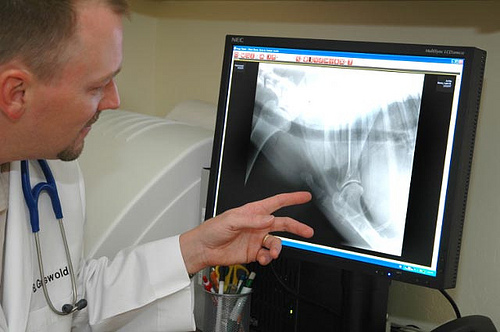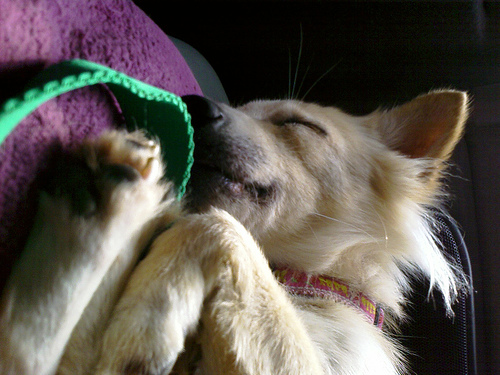Ticks feed on your dog's blood. They can usually be found in wooded areas, or places with plenty of tall grass. They lie in wait for mammals to pass, hoping for the chance to jump aboard and dig themselves in. When your canine passes by a tick (or hundreds of them), it will jump onto him, and attach its mouth to his skin. It will then begin feeding.
There are several types of ticks, and the type determines how long they will feed. In some cases, ticks feed for a few hours, after which they leave their host. In other cases, they can feed for several days, engorging themselves on blood. When females leave their host, they find a secluded spot and lay eggs. They die after they have finished laying their eggs.
A tick's normal life cycle can span between two months and two years, based on the species. This cycle includes four distinct stages: egg, larva, nymph and adult. With the exception of the egg stage, all will feed on a host's blood throughout their development. Below, you'll learn why ticks are dangerous as well as how to remove them from your pet.
Why Ticks Represent A Health Risk
Like mosquitoes, ticks are able carriers for diseases. These can include Lyme disease, Rocky Mountain spotted fever, and anaplasmosis. It often takes hours for ticks to deliver a disease to a canine, so finding and removing the pests can prevent a disease's transmission.
If a tick successfully transmits a disease to your dog, there may be no signs for several days. In some cases, noticeable symptoms may not manifest for weeks. When they do, however, they typically present as weakness, lethargy, and even a loss of limb function. Your dog may also slowly lose his ability to walk. Each of these presentations should prompt you to immediately contact your canine's veterinarian.
Finding And Identifying Ticks
Run your hands slowly over the surface of your dog's body. Take note of raised areas, and pay particular attention to the ears, lips, and skin folds. Ticks migrate to areas that present minimal hurdles to their feeding. This usually means sites with little to no hair.
The size of a tick depends on whether it is at the beginning or end of its life cycle, and whether it has recently fed. A tick that has recently engorged itself can be up to seven or eight times the size of an adult that has not yet fed. Take care not to crush a tick, especially one that is engorged. The contents of its body may carry diseases.
How To Remove Ticks From Your Canine's Body
When you find a tick, use a pair tweezers to grab it as closely to your dog's skin as possible. Part of it will be buried in the skin. Pull it out slowly. If a piece of your canine's skin is pulled off with the buried tick, check for bleeding and wash the site.
During a tick's removal, there will be occasions when its head becomes separated from its body. Try to withdraw the head with the tweezers. If you're unable to do so, there's seldom reason for concern. Your dog's immune system will create an abscess to resolve the problem.
How To Prevent A Tick Problem In The Future
Tick prevention involves a multi-pronged approach. First, if your dog spends a significant amount of time in wooded areas, inspect his coat and skin daily. Second, apply a topical insecticide. Some types can be applied once a month, and will not only prevent ticks from clinging onto your dog's body, but will also kill them. There are also sprays, powders, and shampoos designed to help prevent tick habitation.
Your canine can do very little on his own to keep ticks at bay. He relies upon you for help. Be diligent, and check his coat and skin on a regular basis. You'll protect him from diseases that can potentially lead to debilitating health problems.

 Small Intestinal Bacterial Overgrowth (SIBO) and Pancreatic Insufficiency
When a dog or cat is afflicted with exocrine pancr
Small Intestinal Bacterial Overgrowth (SIBO) and Pancreatic Insufficiency
When a dog or cat is afflicted with exocrine pancr
 Bone Cancer in Dogs
By T. J. Dunn, Jr., DVM
Bone cancer
Bone Cancer in Dogs
By T. J. Dunn, Jr., DVM
Bone cancer
 Anesthetics: What Are They and How Do They Help Your Pet
By T. J. Dunn, Jr., DVM
The perfect
Anesthetics: What Are They and How Do They Help Your Pet
By T. J. Dunn, Jr., DVM
The perfect
 Winter Walking Dangers for Cats and Dogs
If your dog or cat spends any amount of tim
Winter Walking Dangers for Cats and Dogs
If your dog or cat spends any amount of tim
 Making Ends Meet While Eating Healthy - You and Your Dog!
Fitting everything into a tight budget can
Making Ends Meet While Eating Healthy - You and Your Dog!
Fitting everything into a tight budget can